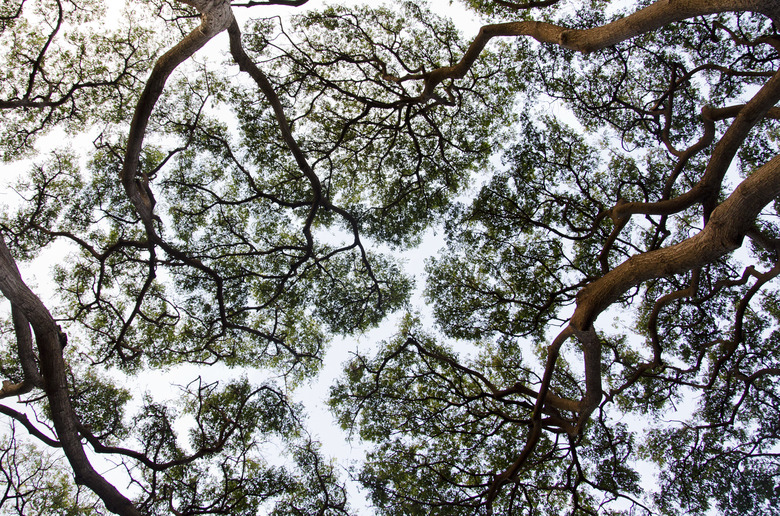What Plants Live In The Canopy Layer?
The rainforest is a specific type of biome that has some of the highest species richness and diversity out of any biome in the world. While they only amount for 6 percent of the entire Earth's surface, they also account for more than half of all of the species of plants and animals that exist.
Scientists divide the rainforest into four distinct layers: the emergent layer, the canopy layer, the understory and the **forest floor.** Of all of these layers, the rainforest canopy layer is home to 90 percent of the organisms in the rainforest, including a majority of rainforest plants.
Rainforest Layers and Canopy Definition
Rainforest Layers and Canopy Definition
As previously mentioned, scientists divide the rainforest into four distinct layers.
The emergent layer is the top most layer of the rainforest. Most of the organisms in this layer are the largest trees that thrust their branches above all the rest and form mushroom-cap-like domes of branches and leaves. They receive direct sunlight, which means they must endure very high temperatures, low amounts of water and large/constant wind gusts. Only hearty and strong plants like hardwoods, evergreens and broad-leafed trees can survive.
The canopy layer forms directly below the emergent layer. It forms to absorb whatever light that's able to penetrate through the emergent layer plants. The plants form a tight and condensed layer about 60 to 90 feet above the forest floor. Many plants climb the branches of the taller ones on the canopy layer in order to get their share of light that filters from above.
The canopy layer absorbs/blocks anywhere between 75 to 98 percent of light from reaching the layers below, which is likely why most life exists in this layer.
The understory is the layer below the canopy. It only receives 2 to 15 percent of all the light that shines on the rainforest. Plants in this area aren't as dense or tight as they are in the layers above, leaving it more open. Many young plants that haven't had the chance to grow to the top two layers live here.
Lastly is the forest floor. Very little light reaches the floor, which leads to little plant growth (except plants adapted for low light levels). Plant and animal debris form a layer here and decomposes.
Rainforest Canopy Layer Plants: Trees
Rainforest Canopy Layer Plants: Trees
Because space is is tight in the canopy layer, many canopy layer trees have long and skinny trunks and have most of their branches at the very top of the plant, almost like an umbrella. This also helps the leaves on the branches survive since there is no light lower down on the tree trunk.
Also, because of the huge amount of rainfall these trees are exposed to (more than 100 inches of rain per year!), many leaves are broad and/or waxy in order for rain to drip and run off of the leaves. This is also why many trees have smooth and sleek bark
Famous rainforest trees include:
- Rubber trees
- Xate trees
- Banana trees
- Teak
- Ceiba
- Cecropia
Rainforest Canopy Layer Plants: Epiphytes
Rainforest Canopy Layer Plants: Epiphytes
Epiphytes are plants that make their home on other plants. They're abundant in the rainforest since not all plants are able to grow as tall as the trees that make up the canopy layer. So, in order to reach light and survive, plants "climb" up the trees and reach the canopy layer that way.
In the rainforest, the plants that climb this way include various species of vines, flowers, mosses, ferns, cacti and more. The majority of the epiphytes in the canopy layer are vines and mosses. Some specific examples include:
- More than 20,000 species of orchids
- Rattan (a specific type of woody vine called lianas)
- Araceae family "creepers"
- More than 2,500 species of vines
- Epiphyllum phyllanthus (a type of epiphytic cactus)
- King ferns
- Scaly tree fern
- Various species of basket ferns
Rainforest Canopy Layer Plants: Bryophytes
Rainforest Canopy Layer Plants: Bryophytes
Bryophytes are non-vascular plants. This includes mosses, liverworts and hornworts. Many bryophytes are epiphytic. They can grow on the branches and trunks of trees in the canopy layer. They can also hang in strands off of trees as well.
Some examples of bryophyte species in the rainforest canopy layer include:
- Spanish moss
- Leafy liverworts (example: _Schistochila appendiculata_)
- Thalloid liverworts (leaf-less, often have "cups" to catch water, for example _Marchantia_)
Cite This Article
MLA
Walsh, Elliot. "What Plants Live In The Canopy Layer?" sciencing.com, https://www.sciencing.com/plants-live-canopy-layer-6950342/. 22 November 2019.
APA
Walsh, Elliot. (2019, November 22). What Plants Live In The Canopy Layer?. sciencing.com. Retrieved from https://www.sciencing.com/plants-live-canopy-layer-6950342/
Chicago
Walsh, Elliot. What Plants Live In The Canopy Layer? last modified March 24, 2022. https://www.sciencing.com/plants-live-canopy-layer-6950342/
